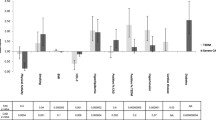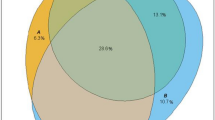Abstract
Avoiding serious complications such as stroke, myocardial infarction, and amputations in diabetes patients is the main interest of long-term treatment. Given the considerable prevalence of diabetes type 2 in industrialized countries this is a major public health concern as well as a burden to health care systems. The present study estimated the current risk of major complications occurring in the German diabetes type 2 population and explored the potential for further risk reduction. Risk reduction can be achieved when physiological and behavioral parameters (HbA1c, blood pressure, cholesterol level, body mass index, smoking) are set to target values recommended in guidelines. To estimate individual risk and potential risk reduction the multifactor disease model Mellibase was employed. Data were obtained from the German Health Survey of 1998, which includes a sample of 7,124 individuals representative of the German population. The survey shows a prevalence rate of 6.3% for diabetes type 2 in persons older than 35 years. The analyses reveal that the overall potential for risk reduction is moderate (e.g., the average reduction potential of the 10-year risk of stroke is 5.7%). A majority of parameter ranges found in the patient population are either already close to the recommended values (HbA1c), are not alarmingly higher than in the general population (blood pressure) or have little impact on risk reduction. In addition nonmodifiable risk factors such as duration of the illness and advanced age constrain possible improvements. However, there is a wide variation in the actual risk between individuals (e.g., the 10-year risk of stroke varies between 2.2% and 79.8%), and thus a wide variation in potential risk reduction (the risk reduction potential for stroke varies between 0% and 53.4%). Intensified treatment should therefore (a) focus on relevant subgroups of patients taking their risk reduction potential into account and (b) aim at improvement in the overall metabolic profile rather than concentrating on single risk factors.



Similar content being viewed by others
Reference
Advisory Councel for the Concerted Action in Health Care (2001) Lessons from ten years of diabetes care in Germany. Appropriateness and efficiency, vol III. Bonn, pp 70–73
Bellach BM, Knopf H, Thefeld W (1998) Der Bundes-Gesundheitssurvey 1997/1998. Gesundheitswesen 60 [Suppl 2]:59–68
Brunetti P, Lucioni C, Schramm W (2002) Terapia combinata con pioglitazone (Actos) nel diabete di tipo2 in Italia: valutazione farmacoeconomica. In: Pharmacoeconomic issues in type 2 diabetes. vol 1, pp 26
Bundesärztekammer (2002) Nationale Versorgungsleitlinie Diabetes Mellitus Typ 2 Kurzfassung. Z Arztl Fortbild Qual Gesundh 96 [Suppl 2]:1–24
Gozzoli V, Palmer AJ, Brandt A, Weiss C, Piehlmeier W, Landgraf R, Renner R (2000) Increased clinical and economic advantages using PROSIT (proteinuria screening and intervention) in type 2 diabetic patients. Dtsch Med Wochenschr 125:1154–1159
Gozzoli V, Palmer AJ, Brandt A, Spinas GA (2001) Economic and clinical impact of alternative disease management strategies for secondary prevention in type 2 diabetes in the Swiss setting. Swiss Med Wkly 131–:303:310
Hauner H, Köster I, von Ferber L (2003) Ambulante Versorgung von Patienten mit Diabetes Mellitus im Jahr 2001. Dtsch Med Wochenschr 128:2638–2643
International Diabetes Federation (2003) Diabetes atlas, 2nd edn. International Diabetes Federation: Brussels
Knight EL, Kramer HM, Curhan CG (2003) High-normal blood pressure and microalbuminuria. Am J Kidney Dis 41:588–595
Kurth BM, Ellert U (2002) The SF-36 questionnaire and its usefulness in population studies: results of the German Health Interview and Examination Survey 1998. Sozpraventivmed 47:266–277
Liebl A, Mata M, Eschwege E; ODE-2 Advisory Board (2002) Evaluation of risk factors for development of complications in type II diabetes in Europe. Diabetologia 45:23–28
Neeser K, Lübben G, Siebert U, Schramm W (2004) Cost effectiveness of combination therapy with pioglitazone for type 2 diabetes mellitus from a German statutory healthcare perspective. Pharmacoeconomics 22:321–341
Mathers CD, Stein C, Ma Fat D, Rao C, Inoue M, Tomijima N, Bernard C, Lopez AD, Murray C (2002) Global burden of disease 2000: version 2 methods and results. Global programme on evidence for health policy discussion paper no 50. WHO: Geneva
Mooy JM, Grootenhuis PA, De Vries H, Valkenburg HA, Bouter LM, Kostense PJ, Heine RJ (1995) Prevalence and determinants of glucose intolerance in a Dutch caucasian population: the Hoorn study. Diabetes Care 18:1270–1273
Palmer AJ, Weiss C, Brandt A, Singh G, Wenzel H (1997) Cost-effectiveness of intensive therapy for type 1 diabetes changes depending on risk factors and level of existing complications. Medl Decis Making 17:528
Palmer AJ, Weiss C, Sendi PP, Neeser K, Brandt A, Singh G, Wenzel H, Spinas GA (2000) The cost-effectiveness of different management strategies for type I diabetes: a Swiss perspective. Diabetologia 43:13–26
Sharma AM, Wittchen HU, Kirch W, Pittrow D, Ritz E, Goke B, Lehnert H, Tschope D, Krause P, Hofler M, Pfister H, Bramlage P, Unger T, HYDRA Study Group (2004) High prevalence and poor control of hypertension in primary care: cross-sectional study. J Hypertens 22:479:486
Stiegler H, Standl E, Frank S, Mendler G (1998) Failure of reducing lower extremity amputations in diabetic patients: results of two subsequent population based surveys 1990 and 1995 in Germany. Vasa 27:10–14
Thefeld W, Stolzenberg H, Bellach BM (1999) Bundes-Gesundheitssurvey: Response, Zusammensetzung der Teilnehmer und Non-Responder-Analyse. Gesundheitswesen 61 [Suppl 2]:57–61
UKPDS Study group, Davies TME, Millns H, Stratton IM, Holman RR, Turner RC (1999) Risk factors for stroke in non-insulin dependent diabetes mellitus: UKPDS 29. Arch Intern Med 159:1097–1103
UKPDS Study group (1998) Tight blood pressure control and risk of macrovascular and microvascular complications in type 2 diabetes: UKPDS 38. BMJ 317:703–713
UKPDS Study group, Adler AI, Stevens RJ, Manley SE, Bilous RW, Cull CA, Holman RR (2003) Development and progression of nephropathy in type 2 diabetes: observation and modelling from the United Kingdom Prospective Diabetes Study (UKPDS 64). Kidney Int 63:225–232
Wolf PA, D’Agostino RB, Belanger AJ, Kannel WB (1991) Probability of stroke: a risk profile from the Framingham study. Stroke 22:312–318
World Health Organization (2002) World health report 2002. WHO: Geneva
Acknowledgements
The authors thank Dr. B.M. Kurth from the Robert-Koch-Institut, Berlin, for helpful discussions.
Conflict of interest:
No information supplied
Author information
Authors and Affiliations
Corresponding author
Appendix: Mellibase disease model description
Appendix: Mellibase disease model description
The Institute for Medical Informatics and Biostatistics (IMIB, Basle) began developing the type-1 and type-2 diabetes models in 1996 to perform risk stratification in the field of health insurances [5]. Adapted versions of this diabetes model were used for the assessment of oral antidiabetic medications in several European countries [3, 14]. The model used in the present study reflects published medical evidence as identified by a regular systematic review. The cohort analysis version of the IMIB model was used in referenced publications. The latest version of the model is called Mellibase. This is based on the IMIB model and allows automated individual risk analysis.
Mellibase is a Markov-based calculation engine with transition matrices and underlying variables, some of which are time-dependent. The diabetes model reflects the course of diabetes mellitus and its associated long-term micro- and macrovascular complications in a range of relevant submodels including the complications of nephropathy, retinopathy, acute myocardial infarction, stroke, and amputation. Simulations are performed for a certain number of years or until death. In each yearly cycle the number of events (including death) and costs associated for each patient are estimated. Surviving patients enter the model in the next cycle, and this process is repeated until the end of the analysis or elimination of the cohort. The results are then combined to estimate the cumulated events and total treatment costs as well as incremental cost-effectiveness for each option considered. The probabilities of developing events are considered to be time, age, gender, and state specific. The events are defined on the basis of key medical prognostic factors such as control of blood glucose levels, hypertension, and hyperlipidemia. The applied transition matrices are based on logical and chronological decision trees, which in a submodel comprise the complete history of a disease-related complication, starting with initial risk profiles, including intermediate outcomes, and leading to the endpoints of each submodel. This approach offers transparency since the model is available in software form with a graphic user interface. The model was published in detail in peer reviewed journals [5, 6, 15, 16].
The diabetes model is based on a summary of data representing epidemiological and clinical evidence from studies such as the United Kingdom Prospective Diabetes Study and many other prospective clinical trials, together with diabetes registery data and meta-analyses appraising diabetes treatments as well as associations between HbA1C levels and a range of micro- and macrovascular events. It is also based on data from the Framingham studies, which assess the relationship between lipid profile and coronary heart disease.
Rights and permissions
About this article
Cite this article
Häussler, B., Berger, U., Mast, O. et al. Risk and potential risk reduction in diabetes type 2 patients in Germany. Eur J Health Econ 6, 152–158 (2005). https://doi.org/10.1007/s10198-004-0274-x
Issue Date:
DOI: https://doi.org/10.1007/s10198-004-0274-x




